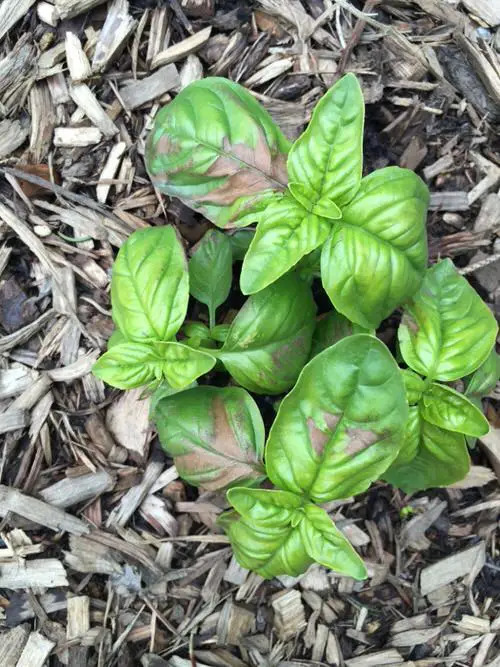Are you worried about your Basil Leaves Turning Black or Brown? Read on to find out what causes them and how to keep the plant safe and healthy!

If you too are facing the problem of your Basil Leaves Turning Black or Brown, then you are at the right post! Here are all the details on why it happens and how to keep this herb plant thriving.
Have a look at the best basil harvesting tips and tricks here
Basil Leaves Turning Black or Brown: Reasons and Solutions
1. Bacterial and Downy Mildew Infections

Many bacterial infections are responsible for black spots on basil leaves. Cercospora leaf spot causes tiny black marks on the leaves. Colletotrichum, on the other hand, results in discoloration of leaves in brown-black color. Septoria fungi make the leaves turn brown with light to deep black borders. These infections contaminate the basil plant and make black or brown spots on the foliage.
Downy mildew is another reason behind black spots on the leaves. A single leaf infected with this disease can spread fast and kill the entire plant. Apart from the spots, you may notice leaf yellowing and later on gray fuzzy on the undersides of the leaves.
Solution:
- Fungal or bacterial infections can be treated through organic or chemical-based fungicides. Refer to the label for instructions.
- You can also mix a few drops of dish soap, and half a teaspoon of baking soda in two liters of water and use it as a spray on the leaves.
- As a precaution, remove all the infected leaves and provide more air circulation.
- Also, avoid wetting the foliage in the evening.
Here are the best types of basils you can grow
2. Exposure to Intense Cold
While growing basil outdoors, unexpected temperature drops might make the leaves develop black spots. As the herb is native to the Indian subcontinent and other warm and arid climatic regions, it is not frost-hardy.
Solution:
Snip away the affected leaves and keep the plant at a location where it is safe and the temperature is above 40 F (4 C). You can also grow it indoors all year round. We have a great article on it here.
3. Sunburn

Sunburn is one of the common causes of black or brown basil leaves. Though the plant does best in full sunlight, the leaves may burn and turn a bit black if it is exposed for long hours in the harsh afternoon sun in the summer. Basil leaves will also become papery and lose moisture when this happens.
Solution:
If the sun is too harsh, move the plant to a place where it can receive shade in the afternoon. Mulching and more frequent watering will also help.
Check out the top harvesting tips for basil here
4. Nitrogen Toxicity or Over Fertilization
Nitrogen toxicity can make leaves yellow, then brown, and eventually black. If you want to know more about its symptoms, click here!
Overfeeding the herb can also cause the edges of the foliage to burn while turning them brown. Discover more about key overfertilization symptoms here.
If the plant is not exposed to the harsh sun and frost or has no downy mildew infection, then this must be the reason behind black spots on the leaves.
Solution:
Feed it once every 6-8 weeks using a balanced fertilizer diluted to half of its strength. Flushing the soil by keeping the plant under a tap and letting the water escape from the drainage hole at the bottom, will help—do this for 4-5 days. You can also change the potting soil, too!
Learn how to propagate basil easily here
5. Overwatering

Excessive moisture in the soil causes root rot that results in the black stems and leaves on the basil plant because roots cannot absorb the nutrients.
Solution:
Keep the plant at a location where it gets plenty of sunlight. Water only when the topsoil feels a bit dry to the touch. Also, make sure that the pot has a drainage hole at the bottom.
6. Pests
While growing basil, always be careful of thrips, spider mites, and aphids. These pests can wreak havoc on the growth of plants and leave black or brown spots on the leaves, which is just an indication of the feces of the insects.
Flea beetle also leaves tiny black spots on the leaves as feces, which makes the foliage look like it has developed deep brown spots on the foliage.
Solution:
To keep pests away from the herb organically, mix 2 whole garlic heads along with 2 tablespoons of turmeric powder. Add 2-3 drops of dishwashing liquid and mix all of them together in a liter of water. Add the solution to a spray bottle, shake well, and spray on the foliage. Also, do not keep the plant in direct sunlight after its application.
We have a detailed article on how to take care of pests naturally here
Other Things that Can Also Cause Black or Brown Leaves in Basil
- Low nitrogen in the growing medium can also cause the leaves to get pale or brown. it also hampers the growth of lush foliage. Use a layer of compost or fertilizer high in nitrogen to solve the issue.
- Over application of pesticides, or applying DIY foliar sprays that include too much quantity of dish soap or neem and any other oil solution can also cause the leaves to burn and turn black.
- Poor air circulation can also lead to black or brown leaves by creating a perfect environment for several diseases to thrive. Keep the herb where it gets proper air circulation. Avoid grouping the plants too closely.



Thank you. loved your article. It was really helpful for my business.
Wish to see more in the coming days.